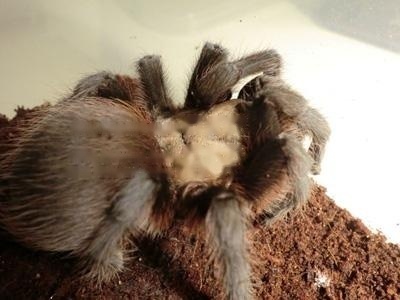
Texas Brown Tarantula
Adult body length is 13-14 cm, suitable temperature is 28-30 ℃, and suitable humidity is 65%. It is recommended to use moist peat, coconut brick and clay as the substrate. It tak
English name: Gooty Sapphire
Origin: Southeast India and Sri Lanka
Sapphire ornate rainforest (scientific name: Poecilotheria metallica) is an arboreal tarantula that lives in southeastern India and Sri Lanka, with a distinctive blue-white pattern. The species has been included in the IUCN Red List of Threatened Species by the International Union for Conservation of Nature, and its endangerment level is "critically endangered".
Chinese name: Sapphire gorgeous rainforest La
Ding scientific name: Poecilotheria metallica
Alternative name: Gooty Sapphire
Kingdom: Animal Kingdom
phylum: Arthropoda
Subphylum: Arachnida
Class: Arachnida
Subclass: Arachnoid Class
order: spiderorder
Suborder: Opisthothelae
Family: Tarantidae
Subfamily: Poecilotheriinae
Subgenus: Gorgeous Rainforest
Species: Sapphire Ornate Rainforest (P. metallica)
Distribution: Southeast India, Sri Lanka Conservation Level National Level
Sapphire ornate rainforest habits and other arborealSpider is similar. In the wild, sapphire ornate rainforests inhabit the hollows of tall trees, weaving asymmetrical funnel-shaped webs. The main food source is various flying insects, which are directly caught (without nets) and then paralyzed. As a gorgeous rainforest, they have a relatively short life cycle. They can grow to maturity in about 2 years. The adult body length is 16-17 cm in foot span. The suitable temperature is 22-26°C and the suitable humidity is 70%. It is recommended for breeders to use Moist peat, coconut bricks are used as substrates.
Sapphire ornate rainforest is supported by many breeders, and its value in the United States can be as high as more than 500 US dollars (In recent years, due to the increase in artificial breeding, the price has gradually decreased). Their value is related to sex: as female spiders live up to 12 years, 3-4 times longer than male spiders, their value is also higher. They are more adaptable and grow faster. Generally, Dubia cockroaches and artificially cultured crickets are used as feed. The feet are fully grown when they are 16 to 18 cm long. The temperature required from juveniles to sub-adults is relatively high and stable, generally 26-28 degrees Celsius, and the temperature requirements for large-scale compression to adults are gradually reduced, and can be maintained at 20-25 degrees Celsius. Regarding humidity, the humidity can be appropriately increased for juveniles to sub-adults, and the pad material should be divided into dry and wet areas. Just keep the water basin and its surrounding pads moist when they become adults.